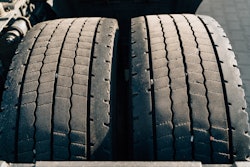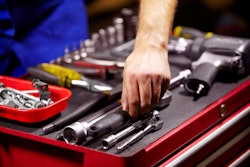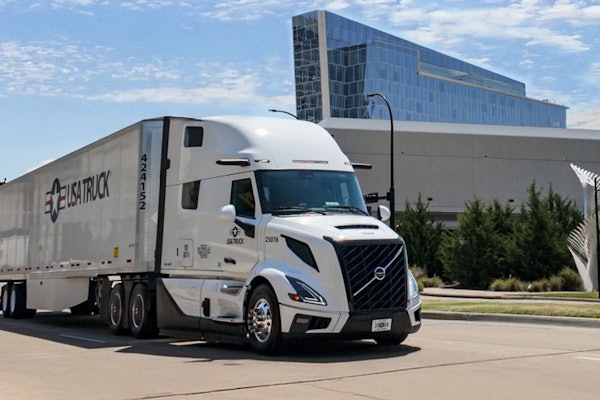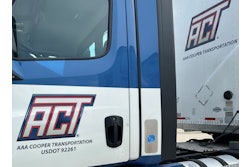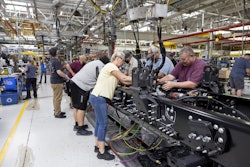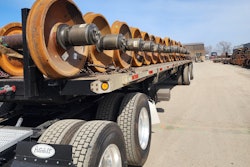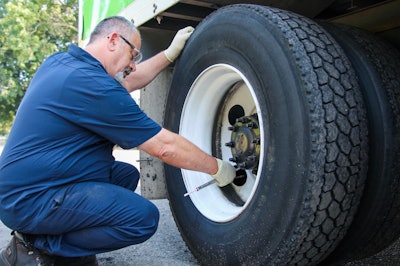
Though fuel prices have reached historic levels, are some fleets still missing the mark on tire pressure management and thus paying even more at the pump?
“Yes,” said Michelin North America Product Manager Jim Garrett. “Especially with today’s high fuel prices, they are losing more cash out of their pocket. Various studies have found that around 10% of fleets are running underinflated with about 5% of tires more than 20 psi under. This is similar to what we see when we monitor fleets.”
Goodyear also sees fleet fuel bills adding up because of overlooked tire pressure losses.
“Absolutely,” said Austin Crayne, business development manager for Goodyear. “When you consider the hundreds of miles truck drivers log per week, tire pressure can be a major factor in fuel economy, and it’s often the easiest to correct.
“A TMC [Technology & Maintenance Council] report on tire pressure monitoring and inflation maintenance says that a tire underinflated by as little as 10 psi reduces fuel economy by about 1%,” Crayne continued. “Stack that up for a truck and a fleet, and that could lead to a serious increase in fuel spend. Especially as fleets experience surges in fuel costs, frequent tire pressure checks are a simple way to save money at the pump over time.”
Continental’s U.S. vice president of truck tire sales and marketing, Tom Fanning, also believes fleets are sacrificing fuel economy with improperly inflated tires and pointed to a multi-year study that shows some surprising results.
“The Continental team in the U.S. and Canada have inspected over 1.1 million tires with air pressure measurements,” Fanning said. “Our 10-year database with 2 million data points shows that about 39% of steers, 34% of drives and 33% of trailer tires are considered underinflated.”
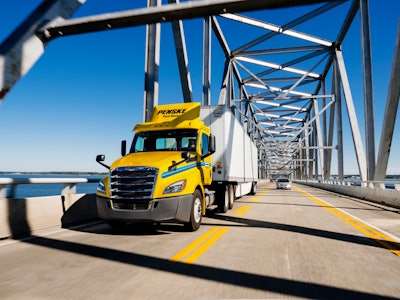 Timing is important when it comes to getting accurate tire pressure readings. “In order to maintain proper air pressure, air pressure should be checked regularly, when the tires are cold," said Charles Sena, senior corporate tire manager, Penske Truck Leasing. "By cold, we mean that the tires have had time to cool down from normal operation, which can take 3-4 hours. In addition, it’s important to ensure that each tire has metal valve caps. Metal valve caps are designed to keep debris out of the stem, which can cause a leak.”
Timing is important when it comes to getting accurate tire pressure readings. “In order to maintain proper air pressure, air pressure should be checked regularly, when the tires are cold," said Charles Sena, senior corporate tire manager, Penske Truck Leasing. "By cold, we mean that the tires have had time to cool down from normal operation, which can take 3-4 hours. In addition, it’s important to ensure that each tire has metal valve caps. Metal valve caps are designed to keep debris out of the stem, which can cause a leak.”
While tire management technology is becoming more available to a wider range of fleets, Mustafa pointed out that tire pressure issues are still more often problematic for smaller fleets that simply lack the resources to more closely manage their tires.
“Sophisticated fleets have access to many data points that can identify when a vehicle is getting less than expected fuel economy,” Mustafa said. “If that same vehicle has had more tire replacements than others with the same specifications, then they will take a closer look at the vehicle to identify the cause. An air pressure issue would certainly be looked at early in that investigation.
“Less sophisticated fleets will suffer from this issue more than others,” Mustafa continued. “Often they lack the resources, personnel or know how to do the type of investigation necessary to identify the root causes of reduced mpg.”
Even as the proliferation of technology has helped fleets to get a better grip on tire management, Yokohama Tire’s senior manager of field engineering, Pat Keating, said there’s still room for improvement.
“No fleet perfectly manages tire pressures,” Keating said. “The adoption of automated pressure systems has helped (especially on trailers), but in many cases there’s more work to be done. Some fleets realize this and some do not.”
Interpretation of underinflation
Few dispute that underinflated tires can rob fleets of fuel economy, but measurable impact can vary depending on the load, tire and temperature.For instance, a North American Council for Freight Efficiency study that found “a truck operating with all tires underinflated by 10 psi will increase fuel consumption 0.5% to 1%,” Mustafa said.
As Crayne made clear, TMC found that a 10 psi loss can lead to a 1% loss in fuel economy.
Proper tire inflation also hinges on load, said industry veteran Joe Puff, vice president of truck technology at NationaLease.
“For the 40 years I’ve been in transportation, tire air pressure has been a challenge,” Puff said. “There are many claims about tire pressure and fuel efficiency – most notably 10 psi low can reduce fuel consumption by 1%. That is assuming the tire pressure set point complies with the manufacturer's tire pressure guidelines.”
As Puff pointed out, this is where tire management can get challenging.
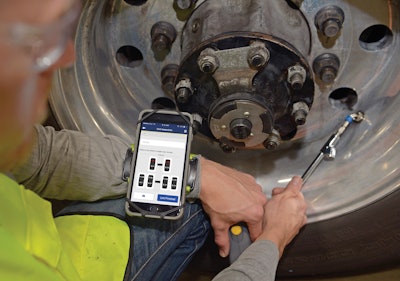 "There are two main causes of tire pressure loss: weather impacts and failure to execute regular tire maintenance," said Austin Crayne, business development manager for Goodyear. "Staying on top of those two factors will have the greatest impact." Goodyear TireOptix app is shown above.Goodyear
"There are two main causes of tire pressure loss: weather impacts and failure to execute regular tire maintenance," said Austin Crayne, business development manager for Goodyear. "Staying on top of those two factors will have the greatest impact." Goodyear TireOptix app is shown above.Goodyear
“For example, operating a standard 12,000 lb. loaded front axle with 22.5 steer tires, one might suggest using 100 psi set point for all their steer tires, which may be ideal for a given application,” Puff continued. “However, use that exact same tire on a 14,000 lb. steer axle load (load not necessarily the axle rating), and the proper pressure may require 120psi to carry the weight. So, if a fleet uses a standard 100 psi pressure set point, the 14,000 lb. loaded axle could actually be 20 psi low even though the tires comply with a fleet pressure setting of 100 psi.”
Tire casing also plays a role in tire pressure management.
“Osmosis or permeation is the ability of air molecules to pass through the structure of the tire rubber, and it can pass through at a rate of 1 to 3 psi per month,” said Mark Finger, senior vice president of maintenance and operations at Transervice.
“The exact air loss is dependent upon the specific tire make and model and the type of compounds utilized in the manufacture of the tire,” Finger continued. “The composition and gauge of the tire inner liner compound also plays a significant role in osmosis.”
Other factors leading to underinflation, Finger said, include slow-leaking punctures (the top cause); leaking valve stems and cores; and air loss through impact breaks like when a tire strikes a curb or object in the road.
Garrett added that wheel damage and poor tire mounting techniques can also lead to pressure loss.
Changes in the season bring on varying temperatures that can also lead to a drop in air pressure.
“Drops in temperature is one of the most common causes of tire pressure reduction,” Crayne said.” “For every 10 degrees the temperature drops, tires lose 1 to 2 pounds of pressure.”
Experts agree that to help maintain proper psi and prevent fuel economy losses, fleets need to implement a tire management program that best addresses conditions that can help prevent air pressure losses. Taking a top-down approach is best, Fanning said.
“Change the corporate culture. The CEO, fleet maintenance director and dispatchers should be talking about the impact of proper air pressure and how it impacts their wallet, especially with downtime and fuel costs,” Fanning said. “Leadership should frequently talk about doing a proper pre-trip. In addition, they should give all new drivers the necessary tools, including a brand new air pressure gauge to be used daily.”
At a time when fuel costs have nearly doubled from a year ago, the slightest variance in fuel economy can make an important difference in an industry known for running tight margins.
“Fleets have a huge opportunity to maximize their fuel spend by monitoring and maintaining optimal tire pressure,” Crayne said. “The real impact for fleets has a lot of changing factors, but one thing is for sure, small changes can really add up in today’s volatile fuel market.”
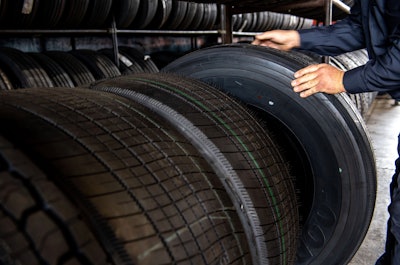 "Tires are porous," explained Daniel Mustafa, director of technical service at Travel Centers of America. "Just as we sweat through our pores, a tire loses a small amount of air right through the rubber that makes up the tire."Travel Centers of America
"Tires are porous," explained Daniel Mustafa, director of technical service at Travel Centers of America. "Just as we sweat through our pores, a tire loses a small amount of air right through the rubber that makes up the tire."Travel Centers of America




